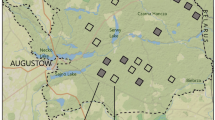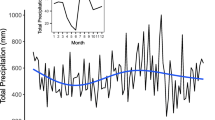Abstract
Pitaya fruit commercialized in southern Jalisco comes primarily from anthropogenic populations. These populations are associated with archaeological sites dating between 300 B.C. and A.D. 1200. Stand structure and productivity of five anthropogenic stands contrast sharply with that of natural and cultivated stands. Individuals from a natural stand have smaller-diameter trunks and canopies and produce less fruit than anthropogenic stands. Structure and productivity of one stand may correlate with the associated archaeological occupation. Individual productivity is highly correlated with diameter of the canopy. Both men and women participate in the harvest and sale of pitaya fruit earning the same or as much as three times that paid as wage laborers. Conservation of these stands and the associated archaeological sites would require land purchase and protection but the sale of pitaya fruits could sustain the efforts necessary to protect and manage these populations over the long term.
Résumé
La mayor parte del fruto commercializado de la pitaya en el sur de Jalisco proviene de poblaciones antropogénicas. Estas poblaciones se asocian con sitios arqueolégicos cuyo antigüedad es de 300 A.C. hasta 1200D.C. La estructura y productividad de estas poblaciones contrasten drasticamente con las de poblaciones naturales y cultivadas. Individuos de poblaciones naturales tienen troncos y copas de menor diametro y producen menos fruto que las antropogénicas. La estructura y productividad de una poblacion relicta se corelacionan con la fecha estimada del sitio arqueológico asociado. La productividad de los individuos se cor-relaciona con el diametro de la copa. Mujeres y hombres participan en la cosecha y venta de frutos, ganando al menos el igual o hasta tres veces lo ganado en formas alternativas de trabajo como jornaleros. La conservatión de estas poblaciones y los sitios arqueológicos donde se encuentran, requerrerian de la compra y protectión de las mismas; la venta del fruto de la pitaya podría sostener los esfuerzos necesarios para protegerlos y manejarlos a largo plazo.
Similar content being viewed by others
Literature Cited
Benz, Bruce F., and Karen Laitner Benz. n.d. Relaciones culturales de la cerámica de Tuxcacuesco y Morett vistas desde El Colomo, Jalisco. Memoria del IV Coloquio de Occidentalistas. ORSTOM-Universidad de Guadalajara, Guadalajara, (in press)
Bravo-Hollis, Helia, and Hernando Sánchez-Mejorada R.. 1991. Las cactáceas de Máxico. Volumes I-III. UNAM, Mexico.
Kelly, Isabel. 1945. The archaeology of the Autlán-Tuxcacuesco area of Jalisco. I: The Autlán Zone. University of California Press: Berkeley.
—. 1949. The archaeology of the Autlán-Tux-cacuesco area of Jalisco. II: The Tuxcacuesco-Za-potitlán Zone. University of California Press: Berkeley.
Laitner Benz, Karen, and Bruce F. Benz. 1994. Las condiciones culturales y ambientales en la Reserva de la Biosfera Sierra de Manant’an en tiempo de la Conquista: Una perspectiva de los documentos et-nohistóricos secundarios. Estudios del Hombre 1: 15–46. Universidad de Guadalajara.
Peters, Charles M. 1994. Sustainable harvest of non-timber plant resources in tropical moist forest: An ecological primer. Washington, D.C.: Biodiversity Support Program-WWF.
Pimienta-Barrios, Eulogio, and Park S. Nobel. 1994. Pitaya (Stenocereus spp., Cactaceae): An ancient and modern fruit crop of Mexico. Economic Botany 48:76–83.
Steenbergh, Warren F., and Charles H. Lowe. 1977. Ecology of the Saguaro: II. Reproduction, germination, establishment, growth and survival of the young plant. National Park Service Monograph Series No. 8. U.S. Government Printing Office, Washington, D.C.
SPSS. 1990. Statistical package for the social sciences. SPSS, Inc., Chicago.
Wilkes, H. Garrison. 1993. El teosinte en México como modelo para la conservac’on in situ: Un reto. Pages 257–270in B. F. Benz, (Comp.), Biologéa, ecologéa y conservacién del géneroZea. Universidad de Guadalajara, Guadalajara, Jalisco, Mexico.
Wilkinson, Leland. 1990. SYSTAT: The system for statistics. SYSTAT, Inc., Evanston, IL.
—. 1990. SYGRAPH: The system for graphics. SYSTAT, Inc., Evanston, IL.
Author information
Authors and Affiliations
Rights and permissions
About this article
Cite this article
Benz, B.F., Santana, F.M., Judith, C.E. et al. The Structure And Productivity Of Relict Stands Of Pitaya (Stenocereus Queretaroensis; Cactaceae), Jalisco, Mexico. Econ Bot 51, 134–143 (1997). https://doi.org/10.1007/BF02893104
Received:
Accepted:
Issue Date:
DOI: https://doi.org/10.1007/BF02893104




